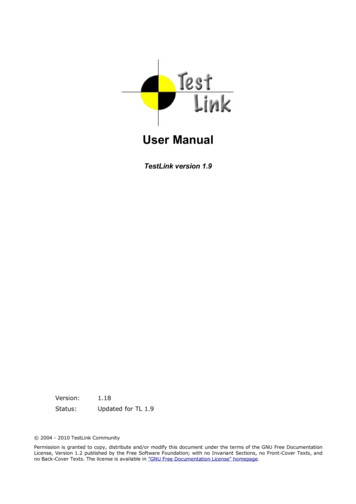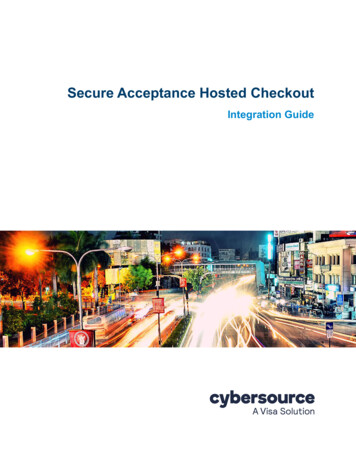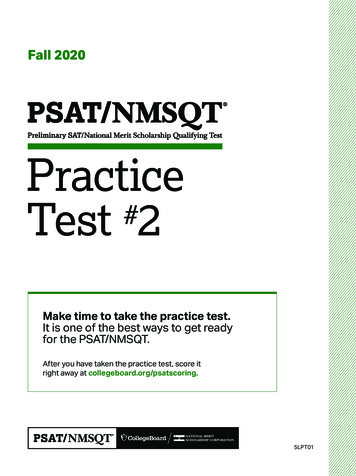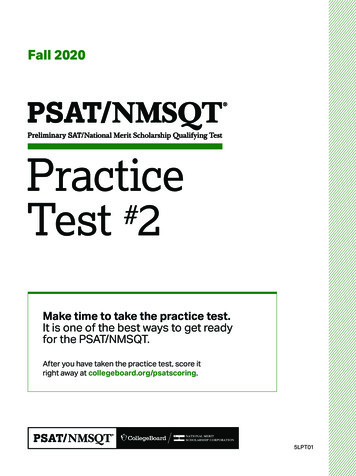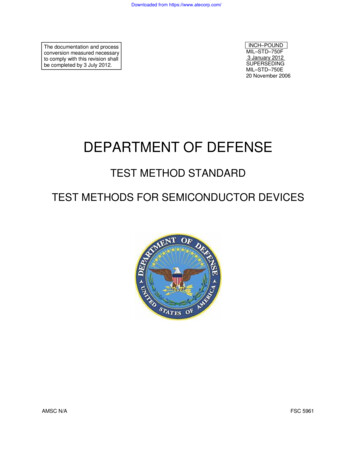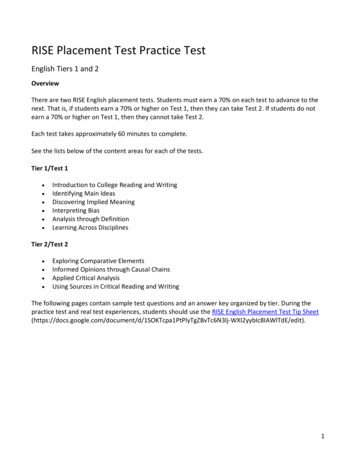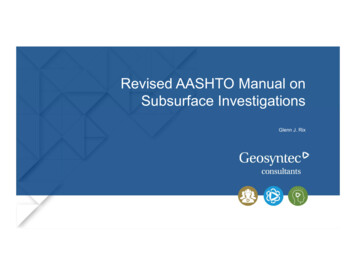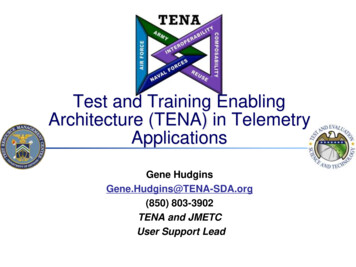
Transcription
Test and Training EnablingArchitecture (TENA) in TelemetryApplicationsGene HudginsGene.Hudgins@TENA-SDA.org(850) 803-3902TENA and JMETCUser Support Lead
TENA Mission Historically, range systems tend to be developed in isolation, focused onspecific requirements, and constrained by agingtechniques/technologies Range infrastructures have grown organically with minimal coordinationor sharing, resulting in duplicated effort and many “stove-pipe” systemsThe purpose of TENA is to provide the necessary enterprise-wide architectureand the common software infrastructure to: Enable interoperability among range, C4ISR, and simulation systems usedacross ranges, HWIL facilities, and development laboratories Leverage range infrastructure investments across the DoD to keep pacewith test and training range requirements Foster reuse of range assets and reduce cost of future developmentsWorking with the Range Community toBuild the Foundation for FutureTest and Training Range Infrastructure2
Benefits of TENA All TENA software and support is free to users TENA is the most capable and sophisticated interoperability solution TENA software is thoroughly tested and very reliable TENA Auto-Code Generation makes creating a TENA application assimple as possible TIDE Tool manages installation and configuration, upgrading and maintenanceAuto-generated starting points mean you never start with a blank pageRapid development of real-time, distributed, LVC applicationsAuto-generated test programs make integration a snapTENA’s technical approach emphasizes cost savings and reliability The TENA software is hard to use wrongTENA catches many user errors at compile time rather than run timeTENA Tools provide unprecedented understanding of an event TENA has a standard object model enhancing interoperability The TENA web site/repository has extensive documentation, training,and collaboration capabilities TENA has a plan for evolution and funding to execute this plan!3
TENA Architecture OverviewTENA ApplicationsTENA ToolsHWILRange ResourceApplicationTENATENAObject TENA lRange DataArchiveTENA MiddlewareTENA MiddlewareTENA Common agement andPlanning UtilitiesObject ModelUtilitiesTENA torsNon-TENA CommunicationsNon-TENASystemNon-TENASystemNon-TENA Applications4
Architecture Management Team(TENA AMT) Current AMT Members: 329 Armament Systems Group (329 ARSG)Aberdeen Test Center (ATC), Aberdeen Proving Ground, MDAir Armament Center (AAC), Eglin AFB, FLAir Force Flight Test Center (AFFTC), Edwards AFB, CAAlaska Training Range Evolution Plan (ATREP)Army Operational Test Command (OTC), Fort Hood, TXCommon Training Instrumentation Architecture (CTIA)Common Range Integrated Instrumentation System (CRIIS)Dugway Proving Ground (DPG)Electronic Proving Ground (EPG)integrated Network Enhanced Telemetry (iNET)Interoperability Test and Evaluation Capability (InterTEC)Joint Fires Integration & Interoperability Team (JFIIT)Joint Mission Environment Test Capability (JMETC)Joint National Training Capability (JNTC)Naval Air Warfare Center – Aircraft DivisionNAWC – Weapons DivisionNaval Aviation Training Systems Program Office (PMA-205)Naval Undersea Warfare Center (NUWC)NAVSEA Warfare Center - KeyportP5 Combat Training System (P5CTS)Pacific Missile Range Facility (PMRF)Redstone Test Center (RTC)T&E/S&T Non-Intrusive & Advanced InstrumentationWhite Sands Missile Range (WSMR)Yuma Proving Ground (YPG)Industry Advising Members BoeingCubic DefenseDRSEmbedded PlanetEMCGeneral Dynamics – C4 SystemsKeneticsKBRWyleLeidosMAK TechnologiesNetAcquireRaytheonScience Applications International Corp (SAIC)Scientific Research Corporation (SRC)Scientific Solutions, Inc. (SSI)Trusted Computer SolutionsInternational Participation AustraliaDenmarkFranceSingaporeSwedenUnited KingdomDesign Decisions / Trade-offs / Status / Technical Exchanges of Lessons Learned / UseCases / Testing / Issues & Concerns Identification, Investigation & Resolution5
TENA Information Assurance(IA) Activities Air Force Evaluated/Approved Product List (E/APL) Navy Application & Database Management System (DADMS) Conditional approval for TENA use on classified and unclassified network enclave, awaiting final approvalUnified Cross Domain Management Office (UCDMO) InterTEC tool suite (includes TENA Middleware) completed DIACAP testing, ATO submission in processDoD PPSMO Category Assurance List (CAL) JTTOCC (which includes TENA Middleware) obtained ATO on NIPRnetAir Force 46th Test Wing DIACAP TENA protocol and TENA-based applications approved for DREN and SDREN sitesNIPRnet Covers TENA Middleware, TENA Utilities, and TENA-enabled applicationsS/DREN (Secret/Defense Research and Engineering Network) Approved 6/27/2011Army Certificate of Networthiness (CoN) Software Certification for TENA Middleware Version 6.xTENA-enabled Cross Domain trusted guard SimShield v2.2.0.1 on baseline listJoint RDT&E Reciprocity Overlay Team (JRROT) Foundational set of controls for basing reciprocity determinations for RDT&ETENA project works with IA organizations to reduce cost and delays to improve IAconsiderations with TENA applications6
Patuxent NAS ATR TM ControlObjective: Develop and field an enterprise approach to remotely manage and operate allcomponents of remote ATR ground telemetry systems. Approach should providecommon interfacing to system components regardless of system manufacturer.Provide for single operator control of several remote TM systems which reduces traveland manning requirements at remote sites.Current TM Approach: Operator Proximity: Current systems require TM Operator to be at location of TMAntenna Control Unit (ACU) during missionso Any near term remote operations concepts require a one-to-one correlation betweenremote ACU and remote TM Antenna, but no sub systems supported Lights Out Operations: No ability to fully power-on, configure, operate, and obtain statusfrom remote Auto-Tracking Telemetry System (ATAS) and Mobile Telemetry AcquisitionSystem (MTAS) systems. Requires personnel on-site to perform power-on and configureall systems. No distributed status available from TM system components. Generalized Interface: Vendor specific interfaces and data models are usedo Operators must gain proficiency on each system componento Prohibits uniform operator consoleso Limited ability to easily access and share relevant metrics and engineering data Information Assurance: Limited ability to meet evolving Information Assurance (IA)requirements and Security Technical Implementation Guides (STIG) on systemcomponents7
Operational View (OV-1)ATC(Bldg. 2118)WallopsPalmdaleRemote Operations:- TM Antennas- TM Receivers- Spectrum Analyzers- Oscilloscopes- Power DistributionReal Time Displays: Antenna Position Signal strength DecommutatorStatus Airplane PositionData Collection Enable post mission analysis Enable cross mission analysisfor range characterization andoptimization8
ARC-TS Roadmap OverviewTCS RemoteControlCurrentEnd StateMalibu & Orbit Status &Remote ControlTCS StatusGDP Bit SyncAddressable Power StripTestingAt PaxVISA Standard (SpecA & O-Scope)TestingLabReal-TimeRemote OperatorStationsRDDS TENAAdaptorsNotional ervisor’sConsole(Access Controls)Common InterfacesRemote OperationsStatus DisplaysRemote Operator ConsoleSupervisor Access ControlsAutonomy and MaintainabilityCost Savings (Remote Manning / Travel)SEMCO ReceiverStatus DisplaysRemote Operations Functionality9
Implementation Strategy Develop vendor agnostic object models and interfaces for the functional systems Develop TENA Adapters for the required functional systems Consider ability to support multiple vendors in the design, e.g., use inheritance,make attributes optionalTENA Adapters will be vendor specific, although sharing implementation code fortypical system interfaces (e.g., SNMP, VISA) will be performed when feasibleDevelop Remote Operator Station (ROS) We would like Range developers to assist in this area to ensure look and feel meetoperator needs and help with broad acceptance within user community Web Browser based user interface approach for status and quick-look informationAvoid using proprietary protocols for remote operations Utilize open architecture with common object models to achieve enterprise solution Utilize common API for all systemsIncremental functionality demonstrations through development sprints will beconducted to integrate lessons learned and mitigate overall program risk10
Object Models (OMs) Object Models Object Models formally define system information and services with support for automatic code generationUsers are permitted to derive extensions to TENA standard OMs, or users can establish their own OMsTENA SDA collects requirements and implementation considerations from user community and candidateTENA standard OMs published for community review and testing purposesRange Instrumentation System Classes (e.g., telemetry, radar, optics) Class inheritance hierarchy (16 separate classes with a total of 120 attributes and 25 remote methods)Intended to be used by range instrumentation system vendors and range organizations, with unique derivedclass with proprietary and legacy attributes when necessary Abstract base classes can be used by subscribing systems that just need basic information common to allrange instrumentation systems (e.g., senior operator needs view of the operating status value for all antennacontrol units independent of any organization/vendor specialized derived classes) Range Instrumentation Pointing and Track Representations A Pointing object is used for instructing an instrumentation system to look at a particular position, potentiallyat a future time (e.g., predicted missile impact position) Range systems can use Pointing objects for multiple operational use cases (e.g., system operator can selecta particular Pointing, system can automatically select the best Pointing, a remote operator can instruct thesystem which Pointing to use) Tracks are based on instrumentation system measurements indicating what was sensed (e.g., azimuth andelevation angles to a test article’s beacon signal at a particular time) Range Instrumentation Sub-System Classes Definition of remote operation interfaces for instrumentation sub-systems, e.g., receiver, spectrum analyzer,controllable power strip, antenna control unit (similar to System class structure where derived classespermitted) Designed for effective, multi-operator, remote monitoring and control of instrumentation sub-systems11
TelemetryAntennaControlSystemClass Hierarchy IllustrationDocumentation maintained in TENA Repository12
Example Object ModelPowerController(aka networked power strip)package TENA {Package TENA used for communitylocal class PowerOutlet {approved standards, but other groups canstring outletName;create extensions or new OMs as necessary.int16 outletNumber;boolean isPoweredOn;optional float32 currentLoadInAmps;Attributes used to characterize the individual};power strip outlets.class PowerController {const string deviceName;Power controller system publishes objectconst string siteName;with identification and status information.PowerControllerState status;Client applications monitor status and canoptional string errorState;invoke methods.vector PowerOutlet outlets;void turnOutletOn (in string outletName);void turnOutletOff (in string outletName);const boolean isEventLogMaintained;vector string getEventLog ();};};Interface specification simplified and comments removed for presentation purposes13
Adapter Approach forRemote Operations What is an Adapter? A software module designed to wrap a particular system with a common systeminterface (with extensibility, when needed) to promote interoperability across differentvendor implementations Adapter can be configured to be used as a stand-alone computer process, eitherrunning on the same computer as the existing system, or an adjacent computer Adaptor can also be configured to be used in-line with an existing system in a virtualnetwork interface manner How are Adapters used? Remote operator GUI-based systems are developed according to the commoninterfaces presented by the adapters in order to break the tight coupling that oftenoccurs with proprietary point-to-point solutions Operator systems are designed from the perspective of supporting the ability toefficiently switch between different sites and different vendor-based systemsooo Support overlapping operators, as well as supervisory monitoringIdentify remote operation fault conditions and promote proper operator procedural handling of these faultsProvide access to vendor specific remote access tools, when that level of access is available and requiredAdditional Adapter Benefits Remote configuration of range instrumentation systems handled in a common manner,permitting the development of tools and infrastructure to minimize configurationproblems Existing data collection capabilities can be used to capture configuration settings andoperational status information related to the range instrumentation systems for eitherduring event or post-event analysis14
Adapter IllustrationEvent ManagementToolsRemote ConfigurationControlSNMPPower ControllerAdapterVISASpectrum AnalyzerAdapterTCPproprietaryTelemetry AntennaController AdapterVISATelemetry ReceiverAdapterRange Instrumentation NetworkTelemetrySiteRemote OperatorStation(s)Range SupervisorStation(s)Data Collection, Analysis,& PlaybackData Visualization Tools 15
Target Architecture16
Bottom Line Up Front – 3 WSMR Deliverables to TRMC1. TENA Capable Range Interface Unit for Radars2. TENA capable Telemetry Tracker pointing data interface – Mod of existing RIU3. Persistent distributed TENA capability through IRCC23Inter-RangeControl CenterRouterFirewallDRENTENA CapableMRTFB1
WSMR DICE“TENA Way Forward” PhasesTENA will be used to connectthe following range systems: FPS-16 RadarsTelemetry SystemsOptics SystemsReal-Time Data Processing(RTDPS, MRTE) – futurePhase 1Phase 318
TENA Adapter TENA::Pointing PAS-XYZ Developed portions of this particular Protocol Converter as a prototype to evaluate particulararchitectural design considerations Need to continue to evolve the implementation into an exemplar for defining the Protocol Converterarchitecture Plan to provide documentation and source code for community reviewAdd some screenshots here19
DICE Object Models TENA-Pointing TENA-RangeInstrumentation (TENA-RI) Standard OM created while working WSMR optics systems several years agoEmerging standard OM structure specifically designed for range instrumentationsystems (see subsequent slides)WSMR-DICE Provides extension to the standard OMs for WSMR specific attributes:enum WSMR::TrackMode {No Track, Acquisition, Coast, Skin, Beacon};WSMR::Pointing extends TENA::Pointing {TrackMode trackMode;};WSMR::Track3D extends TENA::Track3D {int8 AGCquality;int8 bandwidth;TrackMode trackMode;}; Adds LiftoffIndicator and WeatherMeasurements classes20
TENA Enabled TM Controlat YUMA TCS Antenna Control Unit(ACU) model M1 completingTENA interface Remote monitoring andcontrol of telemetry antennasystem using TENA isundergoing operational testing To be used on Yuma TMpedestals Updated controller to beprocured this year with RedHat 6 Operating System21
TENA Enabled TM Dataat RTC UsingTENA to pull real timeTSPI data from the SmartronixOmega NeXT decom software Developed "Data Adapter Tool"in 2 weeks Transporting the data via TENAusing the Standard platformobject model Using SIMDIS to display realtime 3D moving map with theTENA plugin for SIMDIS Data Adapter Tool fuses otherreal time TSPI sources such asIMU and differential GPSTENA22
TENA at Joint Pacific AlaskaRange Complex (JPARC) TENA enables JPARC to provide force-on-force (FOF) training capability that fullyintegrates and supports joint and coalition components for both air and groundtraining in live, virtual, and constructive (LVC) domains“TENA is the greatest thing that ever happened to us. We couldn’t be doing today with all thesesystems–and we couldn’t have all the participants that we do–if it weren’t for TENA”Billy D. SmithChief of electronic combat training requirements for Red Flag at JPARC 23
Common Range IntegratedInstrumentation System (CRIIS) TENA specified in CRIIS acquisition program requirements for groundsystem communication24
Worldwide Use of TENATENA is used in13 countriesoutside the US25
What is JMETC? Acorporate approach for linking distributed facilities Enables customers to efficiently evaluate their warfighting capabilities in aJoint context Provides compatibility between test and training Acore, reusable, and easily reconfigurable infrastructure Consists of the following products: Persistent connectivity Middleware Standard interface definitionsand software algorithms Distributed test support tools Data management solutions Reuse repositoryJMETC Network usingSDRENTENA Software,Object Models, Tools,Repository Providescustomer support team for JMETC productsand distributed testing262
27
How a Test Planner Should ViewJMETCHardware-in-the-Loop (HWIL) AvailabilityBethpage: NG BAMSCNR RadioJLENSWPAFB:SIMAFWhiteman: B-2Redstone (3): DTCC, GMAN, SEDCharleston (2):IPC, MEF-MEUSites in HawaiiPMRF: Bldg 105MHPCCFt Huachuca: JITCFt Hood (2): CTSF, TTECArmyAll linked by JMETCAir ForceNavyMarinesJointIndustry 28
Summary TENA offers significant benefits to the range community Common data standards, interfaces, communication software, and tools toimprove interoperability, reuse, and long-term sustainability of range assets forreduced O&M TENA is the CTEIP architecture for future instrumentation, theJNTC architecture for Live integration, and an enablingtechnology for JMETC JMETC provides inter-range connectivity and supports the fullspectrum of Joint testing, supporting many customers in manydifferent Joint mission threads TENA and JMETC are: Being built and evolved based on customer requirements Partnering with Service activities and leveraging existing capabilities Coordinating with JNTC to bridge test and training capabilities Provide a forum for users to develop and expand the architecture Next TENA AMT-52 week of March 10 in Atlanta Next JMETC User Group week of March 10 in Atlanta29
Important Contact Information TENA Website: http://www.tena-sda.org Download TENA Middleware Submit Helpdesk Case (http://www.tena-sda.org/helpdesk) Use for all questions about the Middleware JMETC Program Office Contact: E-mail: jmetc-feedback@jmetc.org Telephone: (571) 372-2699 JMETC Website: http://www.jmetc.org – under construction TENA Feedback: feedback@tena-sda.org Provide technical feedback on TENA Architecture or Middleware Ask technical questions regarding the TENA architecture or project Provide responses to AMT action items Request TENA training30
Package TENA used for community approved standards, but other groups can create extensions or new OMs as necessary. Interface specification simplified and comments removed for presentation purposes Attributes used to characterize the individual power strip outlets. Power controller system publishes object with identification and status information.
